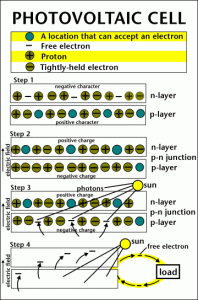Photovoltaic Cells Convert Sunlight into Electricity
A photovoltaic cells are strung together to make a panel, commonly known as a solar panel. This technology will convert solar energy directly into electrical power. A photovoltaic cell is a non-mechanical, meaning it has no moving parts and is generally made from silicon alloys.
Photons Carry Energy
Sunlight is composed of photons, little particles of light energy. These photons contain various amounts of energy corresponding to the different wavelengths of the light spectrum; the ones that are visible to our eyes the wave lengths are represented by different colors.
When photons strike a photovoltaic cell, they may be reflected, pass right through, or be absorbed depending on the wave length. Only the photons that are absorbed provide energy to generate electricity.
The Flow of Electricity
When the electrons leave their position, holes are formed. When many electrons, each carrying a negative charge, travel toward the front surface of the cell, the resulting imbalance of charge between the cell’s front and back surfaces creates a voltage potential like the negative and positive terminals of a battery. When the two surfaces are connected in series with a load, such as an appliance, electricity then flows in a close loop.
How Photovoltaic Systems Operate
 Individual cells can vary in sizes and power. Typically, one cell can only produces about 1 or 2 watts, which isn’t enough power for most applications. To increase power output, individual cells are connected together to make a panel. Panels can be further connected to form an array. The term array refers to the entire generating plant, whether it is made up of one or several thousand panels.
Individual cells can vary in sizes and power. Typically, one cell can only produces about 1 or 2 watts, which isn’t enough power for most applications. To increase power output, individual cells are connected together to make a panel. Panels can be further connected to form an array. The term array refers to the entire generating plant, whether it is made up of one or several thousand panels.
Affects of Weather
The performance of any solar array is dependent upon sunlight. Climate conditions, such as clouds or fog, have a significant effect on the amount of solar energy that will hit the array, which will directly affect your power output. Most modern panels are about 10% efficient in converting sunlight, meaning that only 10% of the energy that hits the panel is converted into electricity. Further research is being conducted to raise this efficiency to 20%.
Applications of Photovoltaic Systems
The simplest photovoltaic systems powers things like small calculators and wrist watches used every day. Larger and more complicated systems provide electricity to pump water, power communications equipment, and even provide electricity to our homes.
Some advantages of photovoltaic systems are:
- Conversion from sunlight to electricity is direct, so that bulky mechanical generator systems are unnecessary.
- PV arrays can be installed quickly and in any size.
- The environmental impact is minimal, requiring no water for system cooling and generating no by-products.
History of the Photovoltaic Cell
The first practical photovoltaic cell was developed in 1954 by Bell Telephone researchers examining the sensitivity of a properly prepared silicon wafer to sunlight. Beginning in the late 1950s, these cells were used to power U.S. space satellites. PV cells were next widely used for small consumer electronics like calculators and watches and to provide electricity in remote or ‘off-grid’ locations were there were no power lines available.

Leave a Reply